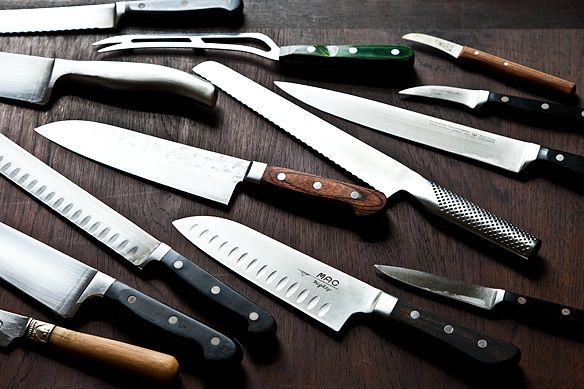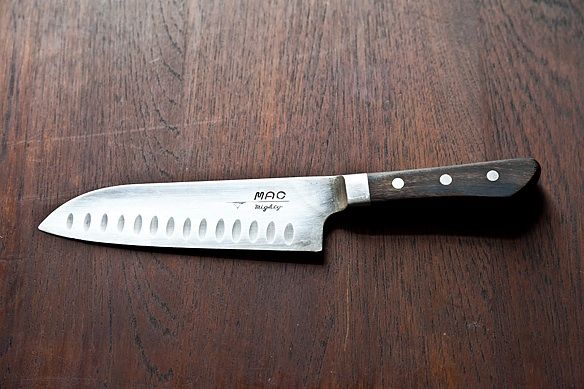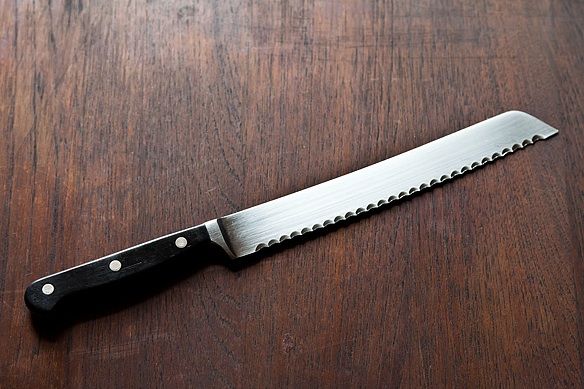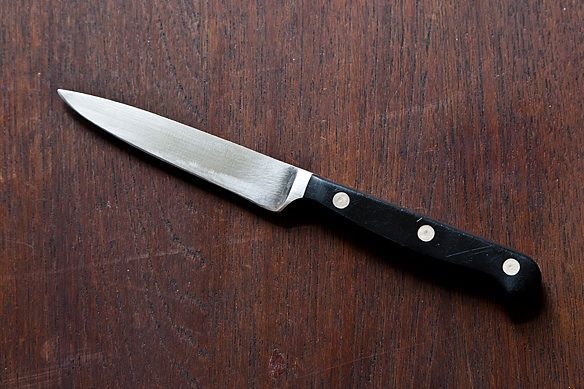Popular on Food52
Continue After Advertisement
20 Comments
CynthiaSeverson
July 27, 2020
Hey, Awesome Post & Great read. I expose my love here .......
My first love is - Shun, Global, Miyabi Kaizen Chef's Knife, then Mac Knife Japanese Series.
My 2nd priority is Waring Commercial WEK200 Cordless Electric Knife, it's good for multiple uses, as like - fish fillet, cutting meat, brisket, bbq, slicing the bread, etc. It offers me smooth cutting. Hope you will also love it.
And finally, I love to carries Gimgige Knife Storage Backpack because of its large amount of pockets. I also carry my apron, 5-6 different size knives, cut resistant gloves, disposable gloves, microplane, mesh strainers, fish spatula, my laptop and other small gadgets, I just love it. I also have a Meissermeister roll bag, it's cool also.
My first love is - Shun, Global, Miyabi Kaizen Chef's Knife, then Mac Knife Japanese Series.
My 2nd priority is Waring Commercial WEK200 Cordless Electric Knife, it's good for multiple uses, as like - fish fillet, cutting meat, brisket, bbq, slicing the bread, etc. It offers me smooth cutting. Hope you will also love it.
And finally, I love to carries Gimgige Knife Storage Backpack because of its large amount of pockets. I also carry my apron, 5-6 different size knives, cut resistant gloves, disposable gloves, microplane, mesh strainers, fish spatula, my laptop and other small gadgets, I just love it. I also have a Meissermeister roll bag, it's cool also.
Steve
September 4, 2017
As long as you know you're buying a quality blade, the most important thing to me is that any knife has to feel right in your hand. Know how to hold and use a knife. then find one that fits you.
How to use? That's skills. A great video is by the Kitchen On Fire guys, Mastering Knife Skills.
I have a 7" Shun Ken Onion Santoku and a matching bird's beak paring knife. My serrated knife is a cheap stamped knife from Marshalls, but I only use that for bread and the like. I cut tomatoes with they Santoku. It is sharp enough. I also have a few others; a good cleaver, a filet knife, etc., but I keep my collection low to minimize clutter.
Next in importance is safety of the blade and of your hands. If you keep knives in a drawer, invest in blade safes like those from LampsonSharp. Wusthoff sells them, too.
Finally, keep your knives true with a good ceramic "sharpening steel." Never cut on a plate, glass, granite... just poly or wood cutting boards. I love bamboo cutting boards.
You can find the video and the knife safes on Amazon.
How to use? That's skills. A great video is by the Kitchen On Fire guys, Mastering Knife Skills.
I have a 7" Shun Ken Onion Santoku and a matching bird's beak paring knife. My serrated knife is a cheap stamped knife from Marshalls, but I only use that for bread and the like. I cut tomatoes with they Santoku. It is sharp enough. I also have a few others; a good cleaver, a filet knife, etc., but I keep my collection low to minimize clutter.
Next in importance is safety of the blade and of your hands. If you keep knives in a drawer, invest in blade safes like those from LampsonSharp. Wusthoff sells them, too.
Finally, keep your knives true with a good ceramic "sharpening steel." Never cut on a plate, glass, granite... just poly or wood cutting boards. I love bamboo cutting boards.
You can find the video and the knife safes on Amazon.
Ashaya
June 28, 2015
WOW....its so new way to write an article about Knives. Honestly, I have read a lot about knives but I've never read something of this sort and style. Its so uniquely written. Hats off to the writer! Great job! Thanks for sharing and please keep writing more such great articles! :)
Best Regards,
Ashaya
Editor, http://knifeadvisor.com/
Best Regards,
Ashaya
Editor, http://knifeadvisor.com/
Ed
March 11, 2014
Well I'm a little late on this one but I collect knives. My knife drawer has 30 knives BUT I have another drawer that has about 40 more, German, Japanese, ceramic, you name it I have it. Most I have never used, so what, I still have them.
talon8
June 20, 2012
I get my knives from here (Disclaimer, I don't work there, I'm just a happy customer):
http://www.knifewear.com/
It's a small shop in Calgary, AB (also in Kelowna, BC) and they sell a large selection of hand made (and some very high quality stamped) blades. The website does online sales too. The owner frequently travels to Japan, and has a good relationship with the traditional Japanese knife makers... He occasionally has a couple MAC and other blades in the store, but they're kind of the bottom end of his blades.
I realize these may not be "starter" knives, but I've used a wide selection of knives, and never have I found anything sharper, or higher quality. I've used good knives, great knives; I keep my knives insanely sharp. These however, are mind blowing. They come in every morning with a large bag of tomatoes, and potatoes for customers to take their blades for a spin.
Anyhow, I currently own a:
- 210mm Suisin INOX Honyaki Gyuto
- 135mm Murata Petty
I also have a few pro Henkels and a Cleaver passed down from my Grandmother. :-)
http://www.knifewear.com/
It's a small shop in Calgary, AB (also in Kelowna, BC) and they sell a large selection of hand made (and some very high quality stamped) blades. The website does online sales too. The owner frequently travels to Japan, and has a good relationship with the traditional Japanese knife makers... He occasionally has a couple MAC and other blades in the store, but they're kind of the bottom end of his blades.
I realize these may not be "starter" knives, but I've used a wide selection of knives, and never have I found anything sharper, or higher quality. I've used good knives, great knives; I keep my knives insanely sharp. These however, are mind blowing. They come in every morning with a large bag of tomatoes, and potatoes for customers to take their blades for a spin.
Anyhow, I currently own a:
- 210mm Suisin INOX Honyaki Gyuto
- 135mm Murata Petty
I also have a few pro Henkels and a Cleaver passed down from my Grandmother. :-)
kasia S.
June 17, 2012
I'm just starting to collect good quality knives, they are expensive and can take some time to find that match :)
Few I use all the time and recommend -
Shun Kaji Fusion 8-Inch Chef's Knife
Kasumi 88024 - 10 inch Chef's Knife
Global G-2 - 8 inch, 20cm Chef's Knife
Global GS-7 - 4 inch, 10cm Paring Spear Knife
F.Dick Premier WACS Bread Knife 8-inch blade
Few I use all the time and recommend -
Shun Kaji Fusion 8-Inch Chef's Knife
Kasumi 88024 - 10 inch Chef's Knife
Global G-2 - 8 inch, 20cm Chef's Knife
Global GS-7 - 4 inch, 10cm Paring Spear Knife
F.Dick Premier WACS Bread Knife 8-inch blade
ChrisVeros
June 13, 2012
I have a block of Farberware knives that cost me $15 that I leave out for my roommates to ruin, and I have no qualms about grinding the bajeezus out of them to make them sharp; The good stuff stays hidden in my knife roll and no abrasives harder than a scrubby sponge get anywhere near them.
I have a 10" Shun Classic; gorgeous but a tad long.
I have a 8" Henckels Profection which has an unusally fat handle but is quickly becoming my favorite.
I have a Chroma Type 301 boning knife, which is a work of art.
I have a 10" Shun Classic; gorgeous but a tad long.
I have a 8" Henckels Profection which has an unusally fat handle but is quickly becoming my favorite.
I have a Chroma Type 301 boning knife, which is a work of art.
rheg18
June 12, 2012
I love my Wusthof 8" Chef and 3 1/2" paring knives. I can't believe I waited so long to invest in good quality knives. I barely use the other ones that I have at home.
babytiger
June 12, 2012
Mac Santoku and Victorinox bread knife - both in my draw, both great for the price.
fiveandspice
June 11, 2012
Truer words were never spoken! Growing up in a house of obscenely dull knives (maaaaybe because my little brothers would sometimes steal them to play sword fight) I was completely blown away by the difference having sharp knives made when I finally got the sense to buy some. You're so totally right that prepping goes from chore to thrill. It's exhilarating, and who really needs all their fingertips anyway?!
pierino
June 11, 2012
I love knives. I'm a total knife guy. I can't stop. Sfmiller's inventory is a great place to begin.
I still have carbon steel knives from my mother, made in Germany (not my mother) but now I'm infatuated with Japanese knives. They do have a tradition of sword making, and well, when it comes to steel and shape... I really dig Shun. I do have one big monster Global forged chef's knife though. As Sfmiller noted the bevel edge on Japanese knives is different than on European style knives. This is due to slicing technique; European cooks push, where Japanese cooks would pull.
There is nothing worse than a dull knife. When I cook in other people's homes I always bring my own bag because one thing is for sure: none of your friends owns a sharp knife.
I still have carbon steel knives from my mother, made in Germany (not my mother) but now I'm infatuated with Japanese knives. They do have a tradition of sword making, and well, when it comes to steel and shape... I really dig Shun. I do have one big monster Global forged chef's knife though. As Sfmiller noted the bevel edge on Japanese knives is different than on European style knives. This is due to slicing technique; European cooks push, where Japanese cooks would pull.
There is nothing worse than a dull knife. When I cook in other people's homes I always bring my own bag because one thing is for sure: none of your friends owns a sharp knife.
Brette W.
June 11, 2012
Words to live by. Thanks so much pierino. Glad someone understands! I'm going to start investigating those Shun knives.
sfmiller
June 11, 2012
Good series. I wish it had been around when my kids were setting up their first kitchens (although, on reflection, I kinda liked the "Dad, what kind of knife/pan/blender/whatever should I get?" phone calls).
One essential that wasn't mentioned (and more often than not isn't in answers to "What knives should I get?" questions: a steel, to keep a honed edge on the tools you're about to spend good money on. Some sort of sharpening implement is useful too: At the high end, an electric sharpener; at the low, a whetstone (IF you know how to use one) or an inexpensive but surprisingly effective Accusharp sharpener (for knives with Western edges, not Japanese). Otherwise, expect to pay to have your knives professionally sharpened periodically.
The knives I use the most (in rough order of frequency)
8" chef's (Global)
6" santoku (Wusthof)
4" paring (Global)
10" bread (Victorinox Fibrox--all their knives are great value)
6" serrated utility (Victorinox)
6" flexible boning (Victorinox)
3" paring (ancient Sabatier)
12" granton edged slicer (Victorinox)
One essential that wasn't mentioned (and more often than not isn't in answers to "What knives should I get?" questions: a steel, to keep a honed edge on the tools you're about to spend good money on. Some sort of sharpening implement is useful too: At the high end, an electric sharpener; at the low, a whetstone (IF you know how to use one) or an inexpensive but surprisingly effective Accusharp sharpener (for knives with Western edges, not Japanese). Otherwise, expect to pay to have your knives professionally sharpened periodically.
The knives I use the most (in rough order of frequency)
8" chef's (Global)
6" santoku (Wusthof)
4" paring (Global)
10" bread (Victorinox Fibrox--all their knives are great value)
6" serrated utility (Victorinox)
6" flexible boning (Victorinox)
3" paring (ancient Sabatier)
12" granton edged slicer (Victorinox)
Brette W.
June 11, 2012
Thanks so much, sfmiller -- this is so helpful! We actually have a video coming out this week on how to sharpen knives.





See what other Food52 readers are saying.